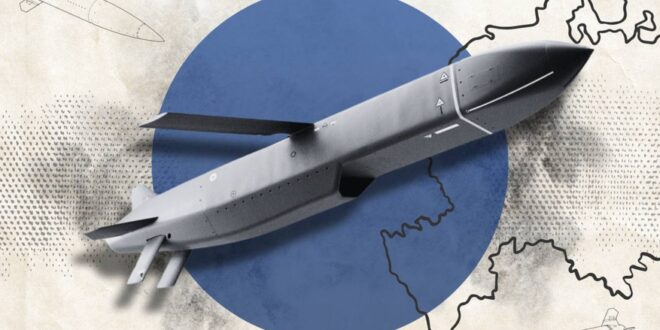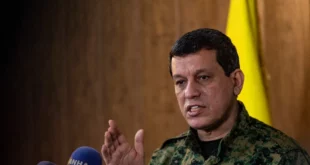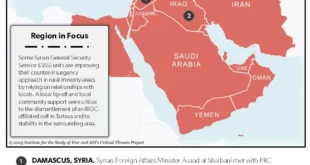After a nearly three-week break, American long-range ATACMS missiles were used again on internationally recognized Russian territory — military facilities in Taganrog were attacked. Summing up the first results of the use of ATACMS and Storm Shadow / SCALP-EG directly against Russia, one can conclude: their effect is very limited due to the fact that a significant portion of suitable targets for them are out of reach of these missiles, as well as due to the small number of strike weapons of this type at the disposal of the Ukrainian Armed Forces. But the fears of those observers who predicted an inevitable escalation were not justified — the Kremlin, in fact, had nothing to respond to the ATACMS strikes with.
What strikes were carried out on Russian territory?
In mid-November 2024, the American press reported ( 1 , 2 ) that the administration of outgoing US President Joe Biden had given the Ukrainian Armed Forces permission to strike long-range missiles at internationally recognized Russian territory. The missiles in question were ATACMS and Storm Shadow/SCALP-EG , which had been transferred to Ukraine earlier but until recently had only been used against targets in the occupied Ukrainian territories.
Since then, the following cases of ATACMS and Storm Shadow / SCALP-EG use have been known in Russia itself:
November 19 — ATACMS attacked the 67th arsenal of the GRAU near the city of Karachev in the Bryansk region. No significant damage was reported.
November 20 — Storm Shadow/SCALP-EG attacked the command post of the North group of troops in Maryino, Kursk Oblast. Eighteen Russian servicemen were reported killed and a high-ranking North Korean military officer was wounded .
November 23 — An ATACMS attack was carried out on an S-400 air defense missile system in the Kursk region. It was reported that two launchers and a radar were destroyed , and five servicemen and three civilian specialists from the Almaz-Antey concern were killed (since the system was undergoing repairs).
November 25 — Kursk (Vostochny) airfield in Kursk region was attacked by ATACMS . No significant damage was reported.
In all cases, the Russian Ministry of Defense not only acknowledged the attacks themselves, but also, in a manner completely atypical for the war in Ukraine, described the damage caused, the losses incurred, and even published photographs of individual elements of the missiles at the “landing” sites ( 1 , 2 , 3 , 4 ).
In between these strikes, Vladimir Putin signed a decree amending the nuclear doctrine, lowering the threshold for the use of nuclear weapons, and for the first time in history, the strategic ballistic missile “Oreshnik” with hypersonic warheads was used in combat conditions – against the Ukrainian city of Dnepr. In a separate statement, Putin emphasized that he took this step “in response to the use of American and British long-range weapons.”
After that, the Ukrainian Armed Forces refrained from new strikes on Russian territory for almost three weeks, until on the night of December 11, 2024, they launched at least six ATACMS (according to the Russian Defense Ministry) at Taganrog. As a result, 41 servicemen were injured at the military airfield and in the location of one of the units , one person was killed.
What targets are within the radius of destruction?
ATACMS and Storm Shadow / SCALP-EG are forcing the Russian command to adapt to the threat of strikes deep in the rear. Vladimir Putin himself recently explained in detail that ATACMS is an analogue of the Russian Iskander operational-tactical missiles, and Storm Shadow / SCALP-EG is an analogue of the Russian Kh-101 air-launched missile. Various modifications of ATACMS have a range of 165 km and 300 km, while the Storm Shadow / SCALP-EG missiles transferred to Ukraine are believed to be limited to a range of 300 km. It should be borne in mind that such expensive missiles are launched at a significant distance from the line of combat contact or the border. Regardless of the type of basing (ground or air), the distance is at least 25-50 km.
In various media outlets, one often encounters ISW ‘s assessment of “hundreds of targets” for Western long-range weapons on Russian territory. In reality, there are far fewer truly important targets (namely military ones, without taking into account critical infrastructure facilities, large industrial enterprises, etc.) .
When assessing the importance of certain objects, it is necessary to seek a balance between the impact that their destruction will have on the situation on the front line and the limited supply of means for their destruction. Such targets primarily include large ammunition depots and military airfields (air bases) , since under current conditions the use of FAB with UMPK is one of the key elements of the fire destruction strategy chosen by the RF Armed Forces.
The Insider has identified and mapped over 30 major ammunition depots and airfields/airbases within range of Ukrainian long-range munitions.
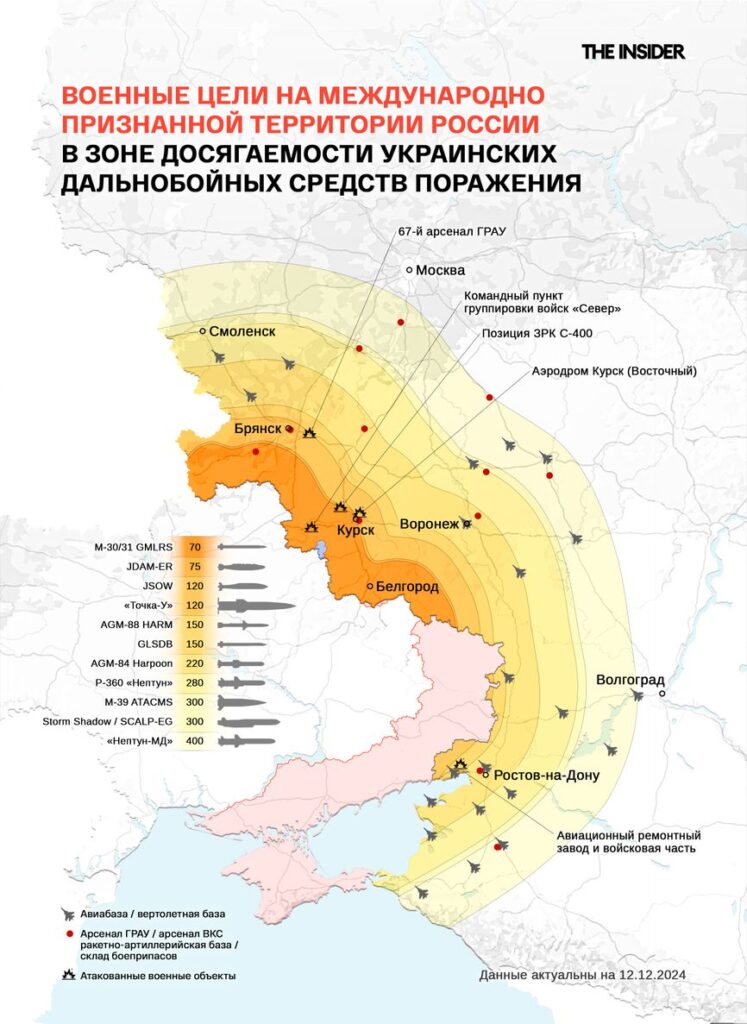
At the limit of their range, Western missiles will also reach the new mooring sites of the Black Sea Fleet ships in Novorossiysk. At the same time, the map deliberately did not include the deployment sites of air defense systems (which are certainly suitable as targets for such strikes), due to their mobility, as well as logistics transport hubs, since ATACMS and Storm Shadow / SCALP-EG missiles are not very suitable for disrupting their work. As for the latter, they are directly designed to destroy command posts, including deep ones, thanks to their penetrating warhead, which was demonstrated on November 20, 2024, by a strike on the headquarters in Maryino in the Kursk region.
Another important nuance is that in order to guarantee the destruction of a target, it is necessary to use many missiles simultaneously, making an adjustment for the operation of Russian air defense. In this case, ATACMS missiles can be used specifically to destroy air defense missile systems, and only after that will the Ukrainian Armed Forces be able to strike Russian territory with weapons of their own design, including missiles and loitering munitions.
How will the use of ATACMS and Storm Shadow affect the course of the war?
It is still unclear within what limits permission has been given to use Western missiles. So far, we know of strikes in the Bryansk, Kursk and Rostov regions – a total of five episodes with a total expenditure (according to the Russian Defense Ministry) of 25 ATACMS and 12 Storm Shadow / SCALP-EG missiles. There is also unconfirmed information about an attempt to strike Yeysk in the Krasnodar region with Storm Shadow.
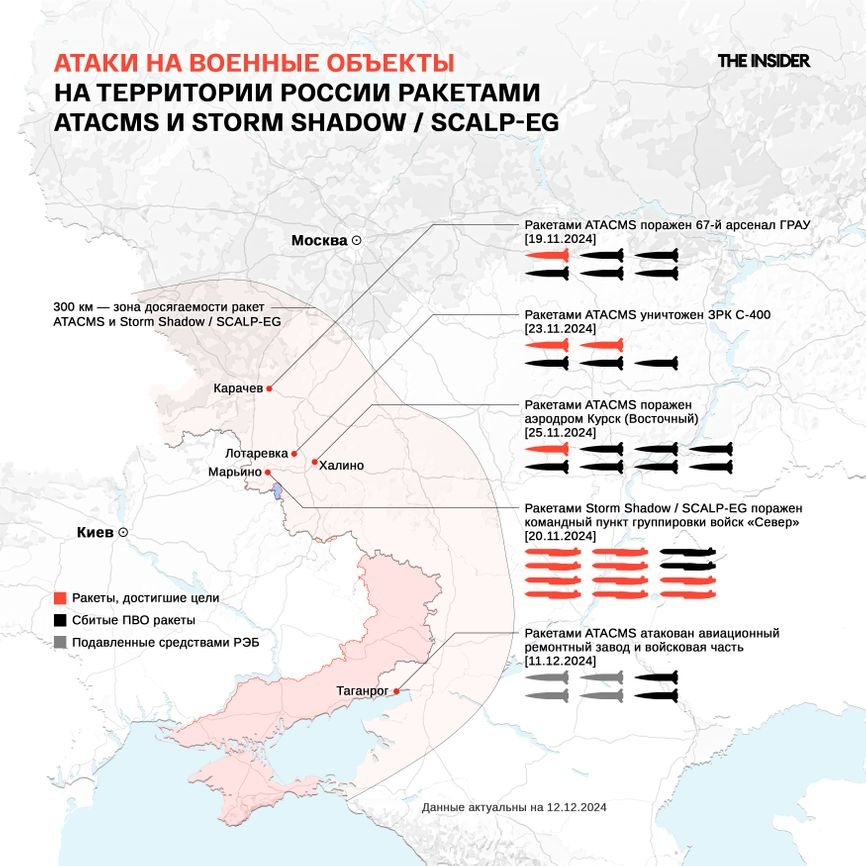
The demonstrated set of targets (two airfields/aircraft repair facilities, one command post, one SAM position and one ammunition storage complex) so far indicates attempts to damage Russian aviation, specifically at the tactical level, as well as to disrupt combat control and “thin out” the air defense coverage zone.
ATACMS and Storm Shadow/SCALP-EG strikes are likely to play a role in the fighting in Kursk Oblast (although Ukrainian troops there have not yet felt much of an effect). According to some reports , the Russian Armed Forces group is tasked with completely eliminating the Ukrainian Armed Forces’ Kursk bridgehead by Donald Trump’s inauguration on January 20, 2025, in order to influence Russia’s negotiating positions, and this is precisely what Ukraine may try to prevent with ATACMS strikes.
To understand how limited the impact of Western missile strikes is, consider one of the largest combined Russian air strikes of the war, which took place on November 17, 2024.
According to Ukrainian monitoring resources ( 1 , 2 ), 15 Tu-95MS, six Tu-160, two Tu-22M3, eight MiG-31K, as well as sea-based carriers of the Kalibr missiles were involved in the preparation and launch of over 100 Kh-101/Kh-555 and Kalibr missiles, eight Kinzhal missiles, and two Kh-22 missiles. The aircraft took off from airfields in the Murmansk, Saratov, and Nizhny Novgorod regions, and the missile launch lines were in the Volgograd and Tambov regions, as well as over the Black and Caspian Seas. Neither ATACMS nor Storm Shadow/SCALP-EG will reach any of the bases where the aircraft are located and air defense systems are stored.
If the decision to deliver Western missiles without any geographic restrictions had been made before the Ukrainian counteroffensive in the summer of 2023, rather than after its failure, the effect would have been much greater. For example, in October 2023, ATACMS demonstrated high efficiency during the strike on a field airfield with helicopters in the Zaporizhia region, but this happened after the summer campaign, when Russian army aviation almost freely fired at Ukrainian mechanized columns.
By September 2024, US officials estimate that there will be almost no targets for Western missiles within the 300-kilometer zone on Russian territory, since 90% of the aircraft launching FABs from the UMPK have been moved further east. Another important limiting factor is the number of missiles themselves. According to calculations by The Insider’s security and defense columnist Colby Bedworth, as of December 2023, the US had only 1,138 missiles with unexpired service lives, with another 1,238 missiles that could be upgraded with service life extensions. Current deliveries of Storm Shadow/SCALP-EG to the Ukrainian Armed Forces amount to “dozens of missiles.”
But by the standards of the current war, this is not so little. According to Ukrainian data , as of September 2024, since February 2022, the Russian Armed Forces have used only 1,300 Iskander missiles (analogous to ATACMS) and 1,846 Kh-101/Kh-555 missiles (analogous to Storm Shadow/SCALP-EG). In other words, if supplies are uninterrupted, Ukraine may have parity in the use of long-range precision weapons, although at this stage the Kremlin has many more of these weapons at its disposal, and they fly much further.
The Kremlin has many more analogues of ATACMS and Storm Shadow / SCALP-EG, and they fly much further
The Biden administration has authorized the use of long-range missiles in response to the appearance of North Korean troops in the combat zone, and not at all to requests from Ukraine itself, which has been seeking such permission for quite some time. At the same time, the diplomatic significance of the decision already taken may be much greater than the military one if ceasefire negotiations begin.
Perhaps the strikes with long-range missiles on Russian warehouses and airfields did have some effect: at least since the end of November 2024, a decrease in the intensity of the use of FABs with UMPK by the Russian side has been recorded .
Thus, the regular use of ATACMS and Storm Shadow / SCALP-EG to the full depth available to them along the front line will affect the planning of the Russian group’s actions: it will inevitably be necessary to build logistics and troop movements, increasing and complicating the transport shoulder and response time to certain challenges.
False escalation
Many observers feared that the use of Western missiles on Russian territory could provoke a new round of escalation. Some media outlets directly linked the authorization for strikes with ATACMS and Storm Shadow / SCALP-EG missiles to a change in the Russian nuclear doctrine, but this is most likely not the case. Vladimir Putin announced the change in doctrine on September 25, 2024, at a meeting of the Permanent Conference of the Russian Security Council on Nuclear Deterrence. The essence of the new version of the document comes down to lowering the threshold for the use of nuclear weapons, and Putin himself previously said that strikes by Western missiles on Russian territory mean direct participation of NATO countries in the Ukrainian war, which changes “the very nature of the conflict.”
In response to the Yuzhmash enterprise in the Ukrainian city of Dnepr, a medium-range ballistic missile called Oreshnik with hypersonic warheads was used. According to Putin, the effect of Oreshnik is comparable to a nuclear weapon and even a meteorite fall , although experts doubt that the missile makes any sense without a nuclear warhead.
It is possible that new strikes on Russian territory will be followed by new launches of the Oreshnik, but a much greater effect, as has happened before when crossing the Kremlin’s red lines, will be produced by the intensification of strikes on critical infrastructure in Ukraine. The use of the Oreshnik is unlikely to have a significant impact on the course of the war in Ukraine (namely, on the Ukrainian theater of operations ). The expected throwing mass of the Oreshnik is 1.5 tons of explosives, which is equivalent to three Iskander quasi-ballistic missiles or three Kinzhals. And the Kremlin obviously has more of these missiles at its disposal than the expensive Oreshniks, which have not yet been adopted for service. At the same time, the results of the use of the Oreshnik against Yuzhmash showed the very limited accuracy and destructive power of the missile.
In terms of the danger of nuclear escalation, nothing has changed: Putin had formal grounds to use nuclear weapons before, and the Russian military had launched potential carriers of tactical nuclear weapons (the same Iskanders and Kinzhals) at Ukraine before. In other words, Oreshnik does not serve military purposes, but rather functions to transmit a political message. And not to Ukraine, but to its allies in the West, primarily in Europe.
As for ATACMS and Storm Shadow / SCALP-EG, the main factors of their effectiveness will be the regularity of deliveries of these missiles to the Ukrainian Armed Forces and the geography of their use against targets deep in Russian territory. Both of these factors depend only on the decisions of Ukraine’s allied countries. But even in the case of positive decisions, the missiles will definitely not turn the tide of the war.
 Eurasia Press & News
Eurasia Press & News
